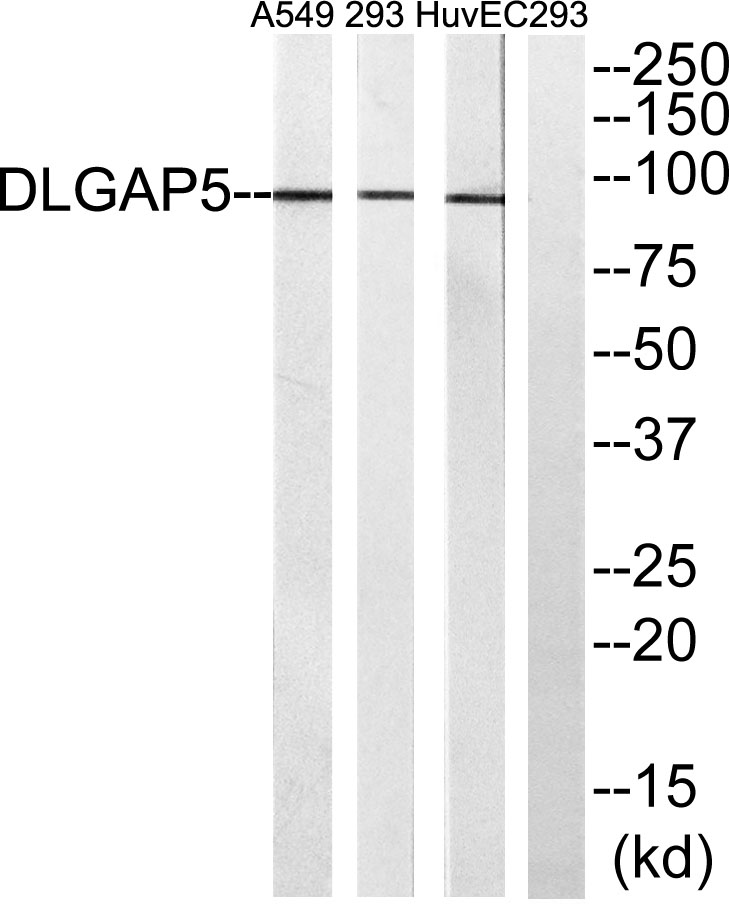HURP Polyclonal Antibody
- Catalog No.:YT2264
- Applications:WB;ELISA
- Reactivity:Human;Mouse
- Target:
- HURP
- Gene Name:
- DLGAP5
- Protein Name:
- Disks large-associated protein 5
- Human Gene Id:
- 9787
- Human Swiss Prot No:
- Q15398
- Mouse Swiss Prot No:
- Q8K4R9
- Immunogen:
- The antiserum was produced against synthesized peptide derived from human DLGAP5. AA range:791-840
- Specificity:
- HURP Polyclonal Antibody detects endogenous levels of HURP protein.
- Formulation:
- Liquid in PBS containing 50% glycerol, 0.5% BSA and 0.02% sodium azide.
- Source:
- Polyclonal, Rabbit,IgG
- Dilution:
- WB 1:500 - 1:2000. ELISA: 1:40000. Not yet tested in other applications.
- Purification:
- The antibody was affinity-purified from rabbit antiserum by affinity-chromatography using epitope-specific immunogen.
- Concentration:
- 1 mg/ml
- Storage Stability:
- -15°C to -25°C/1 year(Do not lower than -25°C)
- Other Name:
- DLGAP5;DLG7;KIAA0008;Disks large-associated protein 5;DAP-5;Discs large homolog 7;Disks large-associated protein DLG7;Hepatoma up-regulated protein;HURP
- Observed Band(KD):
- 95kD
- Background:
- developmental stage:Elevated levels of expression detected in the G2/M phase of synchronized cultures of HeLa cells.,function:Potential cell cycle regulator that may play a role in carcinogenesis of cancer cells. Mitotic phosphoprotein regulated by the ubiquitin-proteasome pathway. Key regulator of adherens junction integrity and differentiation that may be involved in CDH1-mediated adhesion and signaling in epithelial cells.,PTM:Phosphorylated upon DNA damage, probably by ATM or ATR. Decreased phosphorylation levels are associated with the differentiation of intestinal epithelial cells.,PTM:Ubiquitinated, leading to its degradation.,similarity:Belongs to the SAPAP family.,subcellular location:Localizes to the spindle poles in mitotic cells. Colocalizes with CDH1 at sites of cell-cell contact in intestinal epithelial cells.,subunit:Interacts with CDC2. Interacts with the C-terminal proline-rich region of FBXO7. Recruited by FBXO7 to a SCF (SKP1-CUL1-F-box) protein complex in a CDC2/Cyclin B-phosphorylation dependent manner. Interacts with CDH1.,tissue specificity:Abundantly expressed in fetal liver. Expressed at lower levels in bone marrow, testis, colon, and placenta.,
- Function:
- developmental stage:Elevated levels of expression detected in the G2/M phase of synchronized cultures of HeLa cells.,function:Potential cell cycle regulator that may play a role in carcinogenesis of cancer cells. Mitotic phosphoprotein regulated by the ubiquitin-proteasome pathway. Key regulator of adherens junction integrity and differentiation that may be involved in CDH1-mediated adhesion and signaling in epithelial cells.,PTM:Phosphorylated upon DNA damage, probably by ATM or ATR. Decreased phosphorylation levels are associated with the differentiation of intestinal epithelial cells.,PTM:Ubiquitinated, leading to its degradation.,similarity:Belongs to the SAPAP family.,subcellular location:Localizes to the spindle poles in mitotic cells. Colocalizes with CDH1 at sites of cell-cell contact in intestinal epithelial cells.,subunit:Interacts with CDC2. Interacts with the C-terminal proli
- Subcellular Location:
- Nucleus. Cytoplasm. Cytoplasm, cytoskeleton, spindle. Localizes to the spindle in mitotic cells. Colocalizes with CDH1 at sites of cell-cell contact in intestinal epithelial cells.
- Expression:
- Abundantly expressed in fetal liver. Expressed at lower levels in bone marrow, testis, colon, and placenta.
- June 19-2018
- WESTERN IMMUNOBLOTTING PROTOCOL
- June 19-2018
- IMMUNOHISTOCHEMISTRY-PARAFFIN PROTOCOL
- June 19-2018
- IMMUNOFLUORESCENCE PROTOCOL
- September 08-2020
- FLOW-CYTOMEYRT-PROTOCOL
- May 20-2022
- Cell-Based ELISA│解您多样本WB检测之困扰
- July 13-2018
- CELL-BASED-ELISA-PROTOCOL-FOR-ACETYL-PROTEIN
- July 13-2018
- CELL-BASED-ELISA-PROTOCOL-FOR-PHOSPHO-PROTEIN
- July 13-2018
- Antibody-FAQs
- Products Images

- Western Blot analysis of various cells using HURP Polyclonal Antibody
.jpg)
- Western Blot analysis of A549 cells using HURP Polyclonal Antibody

- Western blot analysis of lysates from A549, 293, and HUVEC cells, using DLGAP5 Antibody. The lane on the right is blocked with the synthesized peptide.

- Western blot analysis of the lysates from HT-29 cells using DLGAP5 antibody.



